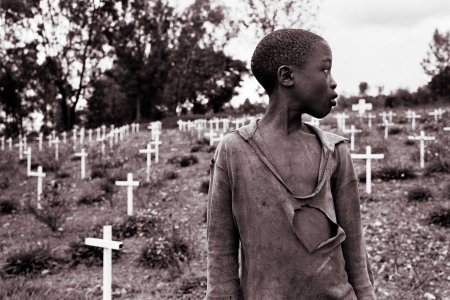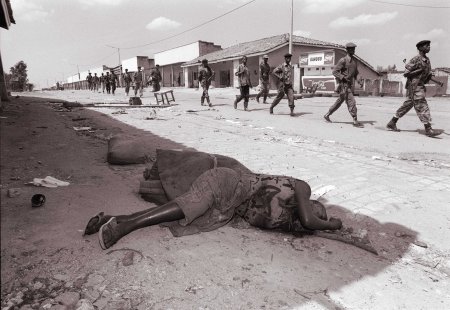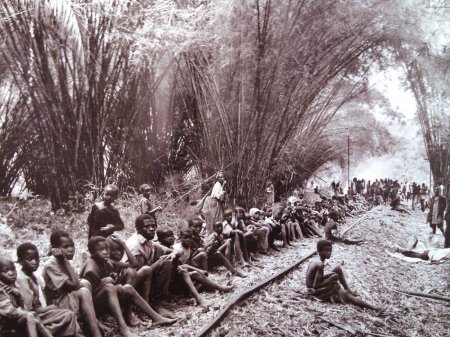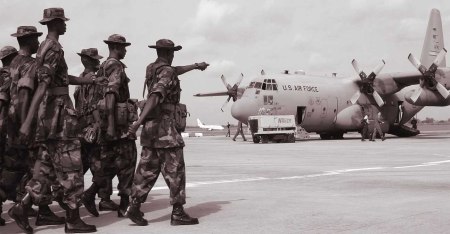Every year in the first week of April Western media channels are flooded with statements about the anniversary of the Rwandan genocide, “where at least 800,000 ethnic Tutsis and moderate Hutus died at the hands of Hutu extremists.”
These statements recount the official narrative about the genocide in Rwanda, a narrative that has seven key elements which have been almost canonized and are repeated mechanically by Western news consumers from all walks of life, economic classes, and political leanings.
1. At least 800,000 people were killed.
2. They were mostly ethnic Tutsis and moderate Hutus.
3. They were slaughtered with machetes or other crude tools.
4. It was meaningless tribal savagery.
5. It was committed by Hutu extremists.
6. The genocide lasted for 100 days.
7. The Western powers were helpless bystanders.
2. They were mostly ethnic Tutsis and moderate Hutus.
3. They were slaughtered with machetes or other crude tools.
4. It was meaningless tribal savagery.
5. It was committed by Hutu extremists.
6. The genocide lasted for 100 days.
7. The Western powers were helpless bystanders.
These jingoistic phrases have been systematically cemented into the minds of the public through more than 20 years of insidious media propaganda, including the press, radio, photographs, videos, and films, recently also reproduced ad nauseam by new social media platforms.
But there is little truth to the official narrative and to get an idea, what really happened it is necessary to recapitulate the background of the so-called “100 days of genocide” (from April 6, 1994 till July 15, 1994). The following paragraphs present crucial facts that anyone who mourns the genocide victims in Rwanda and who wants to help prevent a reoccurrence of such an event ought to understand.
To begin with, Hutu and Tutsi are socio-economic or socio-political categories, and not African tribes, a very important distinction because most of the Rwanda Genocide narrative is mythology relying on simplifications, stereotypes, and misrepresentation about Hutus and Tutsis as tribal savages. This is not the reality, it is stuff right out of Hollywood Tarzan movies.
Prior to the colonial occupation that began after 1890, Tutsi kings ruled Ruanda-Urundi. Tutsi cattle herders comprised some 20 percent of the population, ruling over the 80 percent Hutu majority with egregious violence. First the Germans (till 1916) and then the Belgians (till 1960) managed their colony by nurturing a Tutsi power structure to exploit the Hutu masses. The Tutsi comprador class served the colonial occupation, where brutal suppression, slavery, and terrorism were used to keep the Hutu masses in the fields. A Tutsi could lose all his cattle and descend into the ranks of the peasant Hutu agriculturalists and, though far less likely, a Hutu could gain cattle and join the Tutsi elites. The colonial fathers issued ID cards, measured noses and cranial dimensions, and duly clarified who be Hutu and who be Tutsi.
Witnessing the global Third World independence movements of the 1950s, and supported by Belgian Catholic priests, the Hutus in Rwanda overthrew the Tutsi aristocracy in the revolution of 1959-1960. Many Tutsis fled to Uganda, Tanzania, Europe, and the USA, while others stayed, and the next 30 years saw majority Hutu rule, with Rwanda under constant attack by Tutsi guerrillas.
Noting the winds of change, Belgium quickly swapped their support to the Hutu majority and established a comprador class of Hutu elites to protect the colonial interests. There was, of course, much money to be made.
At the height of the Cold War, the Tutsi refugees influenced the Non-Aligned Movement (comprised of newly-independent states like Brazil, India, and Malaysia), claiming to be “victims of imperial aggression” and agitating for reestablishing their rule. They laid the groundwork for the falsified history of Tutsis as victims and Hutus as oppressors.
Like any aristocratic class, the Tutsi elites believed (and still believe) that they are “god’s chosen people” and the natural-born rulers over millions of Hutu (and lower class Tutsi) peasants.
Adopted by the Non-Aligned Movement, the Tutsi guerrillas — funded, armed by the West, and trained in neighboring countries — attacked Rwanda throughout the 1960s and early 1970s, committing the most egregious terrorism, usually under cover of night. Every time the Tutsi guerrillas attacked Rwanda — whether from outside during the 1960s or from inside during the 1990s — the local French-speaking Tutsis suffered reprisals. The “Tutsis as victims”-narrative continued to expand, and while the Hutus were blamed for occasional retaliatory atrocities, the Tutsis were supported and protected.
Guerrilla incursions involved bombings of cafes, bars, restaurants, and buses. The very real suffering of the French-speaking Tutsi people inside Rwanda was accepted by the RPF (Rwandan Patriotic Front, a political party created in 1987 by the Tutsi refugee diaspora in Uganda) as collateral damage. The English-speaking Tutsi refugees, who had Ugandan citizenship and high posts in the Ugandan military, defined them as Hutu collaborators and didn’t care, if they died.
Enter, by coup d’etat, the Hutu President Juvenal Habyarimana, who ruled Rwanda from 1973 to April 6, 1994, backed by France. Historically, France was to Africa what the USA was to Latin America. Britain and Portugal controlled a few protectorates, Belgium plundered the Congo and Ruanda-Urundi, but Francophone influence in Africa was supreme, all-encompassing, and deeply entrenched.
Habyarimana ran a one-party dictatorship, but French-speaking Tutsis who had stayed in Rwanda were able to achieve economic improvement, though this was overall not significant, given their small numbers.
It was not significant and it was not good enough for the Tutsi elite outside Rwanda. So the Tutsi compatriots under Paul Kagame looked for help and found it easily, because the USA, Canada, and Britain wanted more of the African pie, and Kagame was the man to get it for them.
English-speaking Tutsis who grew up in Uganda, like Paul Kagame, James Kabarebe, Fred Rwigyema, Patrick Karegeya, and Laurent Nkundabatware, were officers in Yoweri Museveni’s guerrilla army. They committed massive atrocities in Uganda through 1980-1985, when absolute terrorism was used to remove the socialist government run by Milton Obote. The victims in Uganda were also blamed for genocide, though crimes against humanity clearly were committed by both sides.
This is how Museveni and Kagame (his director of military intelligence) brought Uganda back into the fold of the West: They burned entire villages. The RPF deceived peasants into coming to meetings only to obliterate them coldly. The RPF even created crematoriums to disappear the dead bodies, using the model of the Holocaust death camps in World War II.
The Nazis, Pol Pot (Killing Fields) in Cambodia, and the Museveni terror apparatus in the Lowero Triangle of Uganda all used the same techniques, yet as only the designated demons of the day are allowed to be accused of genocide, Museveni was never mentioned.
The NY Times led the charge into Rwanda, and Western media started to beat the “Tutsis are victims’” drum roll. Wall Street vultures began drooling and military and intelligence operatives like David Kimche (Israel) and Roger Winter (USA) jockeyed for positions — organizing logistics, maintaining supply chains, arranging weapons shipments — to support Kagame and his guerrilla army RPF. The Washington Post, Boston Globe, CNN, the Guardian, all described the RPF guerrillas as a highly disciplined army. If any women were raped or civilians massacred, it was an accident, a rogue soldier, and said soldier would be duly punished (when they of course never were).
Paul Kagame put into practice what his teachers, the military strategists at the US Army Command and Staff College, Fort Leavenworth, Kansas, taught him: Use psychological operations, relentless propaganda, and terror to overthrow the government.
As the English-speaking Tutsis marched into Rwanda they conscripted and lured Tutsi youth to their “freedom cause”. These were young French-speaking Tutsis who were despite bearing the right label subjected to Kagame’s ruthless modus operandi: Many of them were tortured, killed, disappeared, the chosen ones survived the initiation into the RPF. Kagame and his elite Ugandan comrades didn’t trust Tutsis who had stayed in the country, and they nonchalantly sacrificed the French-speaking Tutsis of Rwanda for the cause of assuming power.
While the military strengths of the RPA grew day by day, supplied from Uganda and funded by World Bank loans to Museveni, the Habyarimana government was attacked by the international community, shackled with debt, subjected to weapons blockades, and demonized by the international press.
Meanwhile, next door in Burundi, the Tutsi-dominated regime committed a genocide in 1972 when some 200,000 to 300,000 mostly Hutu people were tortured, raped, and massacred, while hundreds of thousands others fled to neighboring countries, including Rwanda. The preeminent Africa scholar Rene Lemarchand describes this as a genocide “denied and forgotten.”
Instead of punishing the invading Tutsi Ugandan forces, led by Kagame, the world punished the Habyarimana regime: Political pluralism, multiparty elections, peace accords assuring power-sharing for the RPF: No diplomatic or political sacrifice was good enough to sway world opinion. Meanwhile, Kagames RPF increased its military efficiency and its numbers, it was better equipped, better trained, striking under cover of night like cockroaches (Inyenzi) — the term that Tutsi guerrillas of the 1960s proudly self-identified with.
Just as Museveni had infiltrated, massacred and terrorized Uganda in the 1980s, RPF soldiers disguised as civilians infiltrated Hutu villages, Hutu political parties, even Hutu youth groups, organized to defend Rwanda from the invading terrorist guerrillas. While the RPF used the airwaves to terrify the people, scapegoating and stereotyping enemies real or perceived, and whipping up fear of “Hutu power,” the Western audience only heard about “Hutu hate radio.”
In April 6, 1994, President Habyarimana, his chief of staff, the president of Burundi, and the French pilots died near Kigali in a surface-to-air missile attack on the presidential jet. This is another pivotal world event that has to be commemorated and remembered in connection with the Rwandan genocide: The RPF assassination of two presidents.
The Western media soon began describing this terrorist action as a mysterious plane crash and, using the now-entrenched upside-down narrative that defined Tutsis as the victims and Hutus as killers, the double-presidential assassinations were blamed on Hutu extremists.
The USA blocked every attempt to investigate the plane crash and the International Criminal Tribunal on Rwanda (ICTR) suppressed any evidence which emerged, even removing officials who touched the truth too closely. UN investigator Michael Hourigan charged Kagame for this crime but his report was suppressed. FBI agent James Lyons and Col. Luc Marchal, the second-in-command of the UN Assistance Mission for Rwanda, who came to similar conclusions, were similarly ignored.
UN investigator Robert Gersony confirmed in his report, that RPF cells hat infiltrated Rwanda and at least shared the responsibility for the genocide, yet no Western journalist ever mentioned this. UN Secretary-General Boutros Boutros- Ghali’s repeatedly said: “…The genocide in Rwanda was one hundred percent the responsibility of the Americans.” The only reaction was his replacement.
What was a Hutu extremist? According to the official mythology, it was a Hutu who ruthlessly and coldly set out to wipe every Tutsi off the face of the earth. In reality, a Hutu extremist was any Hutu who saw total war coming at the hands of their erstwhile elite Tutsi oppressors. A Hutu extremist was someone who understood only too well that the elite Tutsis, after infiltrating social, economic, military, and political institutions, were invading from Uganda and massacring thousands of people, wiping entire Hutu villages off the map, bombing public places, and assassinating politicians and journalists.
A Hutu extremist was someone who believed that Hutu’s had a right to defend themselves against the aggressors.
What was a Hutu moderate? Any Hutu who believed that the RPF offered a democratic alternative to a one-party dictatorship and that Paul Kagame was sincere in his proclamations of political pluralism, freedom and brotherhood. They found out too late that these were empty promises.
The genocide of the majority Hutu people proceeded unabated during the RPF march to power in Rwanda, and it was even more clearly executed during the RPF hunting and slaughtering of hundreds of thousands of innocent men, women and children in the DRC (Democratic Republic of Congo).
The Tutsi incursions into Congo were organized campaigns of genocide, with intent to rape, murder and disappear Hutu people because they were Hutu people, and the perpetrators were Kagame’s Tutsi troops. The genocide of Hutu refugees and Congolese alike, committed by Rwandan troops from 1996 until recently, more than equals the Rwanda genocide, but it was a “friendly” genocide, done by an US ally, so there was no need to write anything about it.
No such planning or organization of genocidal intent has been proven against the Hutu government of Juvenal Habyarimana (which, in any case, was decapitated with the plane crash in 1994) or against the interim Hutu government that briefly was in office after April 6, 1994, and the judges at the ICTR have found no evidence of a conspiracy. There were indeed hundreds of thousands of French-speaking Tutsis raped, brutalized and massacred, but there were also hundreds of thousands of Hutus killed, and far more Hutus than Tutsis.
Hutu lands were cleared of their owners and taken by foreign Tutsis who flooded in on the heels of the RPF.
About the myth of the machete swinging Hutu murderers: practically everyone in Rwanda owns a machete. There were massive imports in January of 1994 by a British company and purchases of machetes were facilitated by World Bank funds for agricultural use, not for an evil genocide conspiracy. Anyway, the RPF routinely killed people with machetes, to save bullets and to disguise the perpetrators.
Today, the Tutsi aristocracy reigns unchallenged in Rwanda. Paul Kagame’s government asserted its power in the run-up to the 2010 presidential elections, when authorities barred most opposition political parties from registering for elections, closed down many independent newspapers, and witnessed the flight into exile of several prominent government officials who said they “feared for their lives.”
One of the exiled officials, Kagame’s former chief of staff, Faustin Kayumba Nyamwasa, was shot in the stomach in South Africa after openly criticizing the Rwandan government. A Rwandan journalist, Jean Léonard Rugambage, was killed shortly after his article, which pointed to government complicity, was published. The deputy leader of the Green Party, which was among those unable to register, was found dead with his head partly severed. A UN report led by veteran Rwanda expert Filip Reyntjens stated that “there is overwhelming evidence of responsibility for war crimes and crimes against humanity” against Kagame.
Rwanda’s Supreme Court recently sentenced opposition leader Victoire Ingabire to 15 years in jail. Ingabire is a Hutu and a leading critic of President Paul Kagame, she joins the likes of Deo Mushayidi, Bernard Ntaganda, and Dr. Theoneste Niyitegeka, who are also languishing in prison for political reasons.
As the most important mining areas of the DRC have been conquered and made ready for the exploration by Western companies, Kagame’s troops are on the move again to the next venues, which are the CAR (Central African Republic) and South Sudan. The USA just airlifted a Rwandan mechanized battalion with giant C-17 Globemaster III planes to the CAR.
History is written by the victors and it always reflects the view of the victors. Winston Churchill once said: “History will be kind to me for I intend to write it” (which he in fact he did in no less than 1031 pages). Kagame doesn’t need to write a history book by himself, the Western journalists and pundits do that for him and take care that the readers and viewer believe exactly what Kagame and his backers want them to believe. “We stood by, we did nothing, we should have stopped the genocide.”
The alternative narrative about the RPF incursion and Kagame’s crimes against humanity is hidden from the eyes of the world. Nobody dares to tell, that a proxy army of elite Tutsis murdered undisturbed and unrestrained in Burundi, Uganda, Rwanda, and Congo, and that this proxy army still continues to murder largely undisturbed and unrestrained.
Further reading: http://www.rwandahope.com/RwandaMythandreality.pdf






Keine Kommentare:
Kommentar veröffentlichen